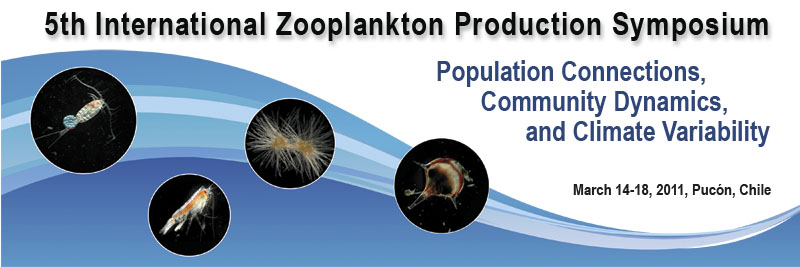Manuscript submission instructions
Manuscripts that authors wish to have considered for the special symposium
issue of the ICES Journal of Marine Science need to be submitted online
through the IJMS ScholarOne Manuscripts website (http://mc.manuscriptcentral.com/icesjms)
or by clicking “Submit electronically” at the Oxford Journals
website (http://icesjms.oxfordjournals.org).
The deadline for receipt of manuscripts is 31
March 2011 (which is based strictly on the publication
schedule of the Journal), but a few extra days may be allowed to very
few authors if they negotiate in advance a receipt date with the lead
guest editor Julie Keister (jkeister@u.washington.edu).
Read the Instructions to Authors and follow the Online Submission Instructions,
noting particularly the need to classify the manuscript as a symposium
one (select 5th International Zooplankton Symposium from the drop-down
menu); then press Submit Now! Questions on technical issues related
to submission may be directed to Margaret Searle (icesjms.editorialoffice@oup.com).
Please note, however, that the symposium has been granted a finite page
budget of 250 pp, so to accommodate as many papers as possible, authors
are asked to limit their manuscript size to the following maxima (note,
these are higher limits and not targets): Abstract, 200 words; core
text (from Introduction to Acknowledgements), 5500 words; core references,
50; tables and artwork together, 8 of modest size, fewer if they are
large. Motivation to exceed these limits may be provided, but will need
to be very strong to succeed. Appendices in the Journal are
supplanted by Supplementary material as the preferred means of publishing
material not suitable for the core text. During the online submission
process, you will be asked to supply the following information.
(1) In a cover letter, you must provide a written justification as
to why you believe the content of the paper is relevant to the special
symposium issue of the Journal, highlighting the paper’s
research significance and particularly its innovative message, along
with its primary scientific contribution.
(2) Include names and current contact addresses (including e-mail addresses)
of three appropriate referees who have not been associated with the
research being published, or closely affiliated with any of the authors
in the past five years.
(3) Confirm that the material is original, is not submitted elsewhere,
and has the full written approval of all co-authors
to submit.
(4) Confirm that the author has adhered to general guidelines for the
ethical use of animals in research, the legal requirements of the country
in which the work was carried out, and any institutional guidelines
(if national certificates are available, append those). If ethical considerations
arose in the course of the study, the author should describe in the
manuscript how those considerations were addressed. In exceptional
cases, where unresolved ethical questions remain, the manuscript may
be sent to appropriate experts in the ethical use of animals in research
for additional refereeing. In such cases, the decision as to whether
the manuscript is accepted for publication remains with the guest editor
or, in the final instance, the Journal’s Editor-in-Chief.
Failure to adhere to these four requirements and the size criteria
in the first paragraph will result in the rejection of your submission,
without assignment to associate guest editor or review. Remember that
it will be competitive (based on available publishing space as much
as on quality) to get your manuscript accepted in the issue, so adherence
to guidelines will have to be the first criterion for selection.
Ideally, text and figures should be in separate files, and manuscript
texts should be submitted preferably in MS Word format; other formats
may be accepted on prior agreement, but DO NOT send
manuscript texts in PDF format.
